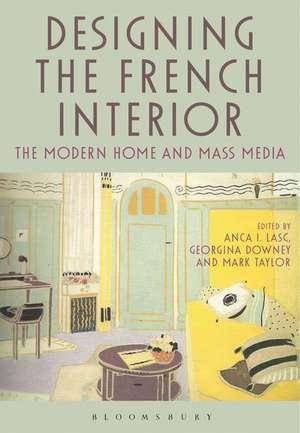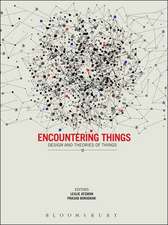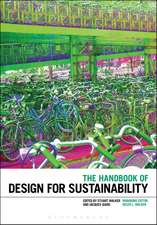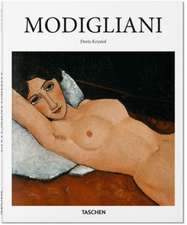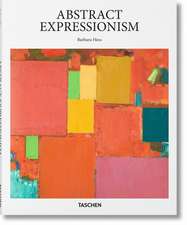Designing the French Interior: The Modern Home and Mass Media
Editat de Anca I. Lasc, Georgina Downey, Mark Tayloren Limba Engleză Hardback – 21 oct 2015
| Toate formatele și edițiile | Preț | Express |
|---|---|---|
| Paperback (1) | 200.89 lei 3-5 săpt. | |
| Bloomsbury Publishing – 25 ian 2017 | 200.89 lei 3-5 săpt. | |
| Hardback (1) | 716.96 lei 6-8 săpt. | |
| Bloomsbury Publishing – 21 oct 2015 | 716.96 lei 6-8 săpt. |
Preț: 716.96 lei
Preț vechi: 916.99 lei
-22% Nou
Puncte Express: 1075
Preț estimativ în valută:
137.23€ • 149.12$ • 115.35£
137.23€ • 149.12$ • 115.35£
Carte tipărită la comandă
Livrare economică 22 aprilie-06 mai
Preluare comenzi: 021 569.72.76
Specificații
ISBN-13: 9780857856593
ISBN-10: 0857856596
Pagini: 248
Ilustrații: 52 bw illus
Dimensiuni: 169 x 244 x 18 mm
Greutate: 0.61 kg
Editura: Bloomsbury Publishing
Colecția Bloomsbury Academic
Locul publicării:London, United Kingdom
ISBN-10: 0857856596
Pagini: 248
Ilustrații: 52 bw illus
Dimensiuni: 169 x 244 x 18 mm
Greutate: 0.61 kg
Editura: Bloomsbury Publishing
Colecția Bloomsbury Academic
Locul publicării:London, United Kingdom
Caracteristici
Unique collection focusing on the development of the French interior from pre-Revolution to 1970s
Notă biografică
Anca I. Lasc is Assistant Professor of history and theory of design at Pratt Institute, New York City, USA. Georgina Downey is an independent scholar and Visiting Fellow in the graduate art history program at the University of Adelaide, Australia. Mark Taylor is Professor of architecture at The University of Newcastle, Australia.
Cuprins
French Connections: The Modern Interior and Mass Media, Anca I. Lasc, Georgina Downey and Mark TaylorSection 1: Sex, Dreams, and Desires: The Perversions of the Modern Interior1. Impolite Reading and Erotic Interiors in Eighteenth-Century France, Georgina Downey and Mark Taylor, University of Adelaide and University of Newcastle, Australia2. Intimate Vibrations: Inventing the Dream Bedroom, Fae Brauer, University of East London, UK3. Angels and Rebels: The Obsessions and Transgressions of the Modern Interior, Anca I. Lasc, Pratt Institute, USA4. Machines and Monsters: The Modern Decadent Interior as Spectacle in Huysmans's À Rebours, Emilie Sitzia, Maastricht University, Netherlands5. La Maison Suspendue: Imaginary Solutions for an Everyday Domestic Machine, Peter Olshavsky, University of Nebraska-Lincoln, USASection 2: Aesthetics, Anxiety, and Identity: Reproducing a Decadent Domesticity6. The Interiorization of Identity: Portrait Busts and the Politics of Selfhood in Pre- and Early Revolutionary France, Ronit Milano, Ben-Gurion University of the Negev , Israel7. A Portable Keyhole into the Fictional Apartment Building: The Interiors of Félix Vallotton and Émile Zola, Karen Stock, Winthrop University, USA8. The Fin-de-siècle Poster: A Healthy Modern Stimulus in the French Interior, Katherine Brion, University of Michigan, USA9. Mode of a Modern Muse: Fashion and Interior in Édouard Vuillard's Paintings of Misia Natanson, Jess Berry, Griffith University, Australia10. The Decadent Interior as Modern Lesbian Aesthetic, Elizabeth Melanson, University of Delaware, USA11. Mallet-Stevens, Modern Design and French Cinema, Nieves Fernández Villalobos, Universidad de Valladolid, SpainSection 3: Intimacy, Longing and Performance: The Consumption and Display of the Celebrity Home12. Staging Domesticity in La Revue Illustrée's Photo-Interviews: Belle Époque Celebrity Homes in the Periodical Press, Elizabeth Emery, Montclair State University, USA13. Hôtel Baronne Salomon de Rothschild 1872-1878: The Imprint of a Legacy, Linda Stevenson and Susan Tate, University of Florida, USA14. 'Un Bel Atelier Moderne': The Montparnasse Artist at Home, Louise Campbell, Warwick University, UK 15. Housing the New Dandy: Designing Lifestyle in Monsieur Magazine, 1920-1924, John Potvin, Concordia University, Canada16. 'Fashions in Living': The Duke and Duchess of Windsor, 4, Route du Champs d'Entraînement, Paris, Peter McNeil, University of Technology Sydney, Australia17. 'Si ma cuisine m'était comptée': Paris Match and the Salon des arts ménagers during the Fourth Republic, Guillaume De Syon, Albright College, USAIndex
Recenzii
Focusing on the French period from pre-revolutionary times through the late 20th century, 17 essays from 19 contributors are divided into three sections addressing the importance of various media and their shaping of residential interiors. It delves into the contributions of drawings, prints, pattern books, illustrated magazines, department catalogs, guidebooks, and films in promoting French interior design to the rest of the world. A reasonable number of black-and-white photos and reprints of posters, drawings, and publications enhance the written word, but should not be the only reason for picking acquiring this tome. The primary audience appears to be not only students and professionals, but also anyone who has sought information about the influences of French interiors on residential design. Summing Up: Recommended. All readership levels.
Designing the French Interior is exactly the kind of book a history buff will love - be that buff a professional one, someone studying or just a casual hobbyist. If you have an interest in design, decorative arts, fine art, and the evolution and impact popular media can have on trends and movements, then you'll likely enjoy this read.
This engaging text draws the reader into a unique account of the interdisciplinary nature of the modern French interior. Immersing the reader in topics such as the intricate histories of the French boudoir and transformations in public and private life the text traces the history of the modern French home.
The scholars involved in this volume have located the study of the interior within the rich intellectual tradition that exists in the areas of French fine art, literature, film and cultural studies. In so doing it brings new approaches and ideas to the wider subject of the modern interior.
This text offers a provocative examination of French interiors from the 18th to 20th century. The essays frequently decode primary French resources, making them accessible to a much wider audience. The use of mass media as a filter for analysis underscores the manner in which interiors were communicated, consumed, interpreted and valued.
This volume of essays, which presents the modern French interior as a space of intimacy, sexuality and identity, has an array of international scholars who are pushing boundaries in many new and innovative ways. Exploring France as a 'fashion leader', they show importantly how the interior was displayed, mediated and staged.
Designing the French Interior is exactly the kind of book a history buff will love - be that buff a professional one, someone studying or just a casual hobbyist. If you have an interest in design, decorative arts, fine art, and the evolution and impact popular media can have on trends and movements, then you'll likely enjoy this read.
This engaging text draws the reader into a unique account of the interdisciplinary nature of the modern French interior. Immersing the reader in topics such as the intricate histories of the French boudoir and transformations in public and private life the text traces the history of the modern French home.
The scholars involved in this volume have located the study of the interior within the rich intellectual tradition that exists in the areas of French fine art, literature, film and cultural studies. In so doing it brings new approaches and ideas to the wider subject of the modern interior.
This text offers a provocative examination of French interiors from the 18th to 20th century. The essays frequently decode primary French resources, making them accessible to a much wider audience. The use of mass media as a filter for analysis underscores the manner in which interiors were communicated, consumed, interpreted and valued.
This volume of essays, which presents the modern French interior as a space of intimacy, sexuality and identity, has an array of international scholars who are pushing boundaries in many new and innovative ways. Exploring France as a 'fashion leader', they show importantly how the interior was displayed, mediated and staged.
